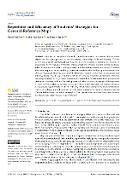Repertoire and efficiency of students' strategies for general-reference maps

Datum vydání
2022Publikováno v
ISPRS International Journal of Geo-InformationRočník / Číslo vydání
11 (2)ISBN / ISSN
ISSN: 2220-9964Metadata
Zobrazit celý záznamKolekce
Tato publikace má vydavatelskou verzi s DOI 10.3390/ijgi11020138
Abstrakt
Maps are not just powerful tools to communicate spatial information; they also have significant educational potential to develop students' knowledge, skills, and thinking. To fully exploit this potential, deep research is needed into map-use processes considering the variability of map types and the cognitive complexity of map operations. Whereas research on map reading is relatively common, the research into cognitively more demanding operations is lacking. Therefore, this study employed an eye-tracking experiment combined with a follow-up questionnaire with 20 upper-secondary students to examine the strategies students choose when analyzing general-reference maps. Specifically, attention is paid to the strategy repertoire, distribution, efficiency, and adaptiveness of strategy choice. Subsequently, the study is focused on students' perception of strategies. According to the results, participants used a rich repertoire of strategies (although many of them unconsciously) and adapted the strategy choice to task demands. The solution efficiency varied among task demands, as did the efficiency of individual strategies and their combinations. The research design allowed a comparison with earlier studies on strategies for thematic map use. The results should be of interest to cartographers (to design effective educational tools) and educators (to educate map users complexly and effectively).
Klíčová slova
eye-tracking, strategies, map analysis, general-reference map, upper-secondary education
Trvalý odkaz
https://hdl.handle.net/20.500.14178/1946Licence
Licence pro užití plného textu výsledku: Creative Commons Uveďte původ 4.0 International






